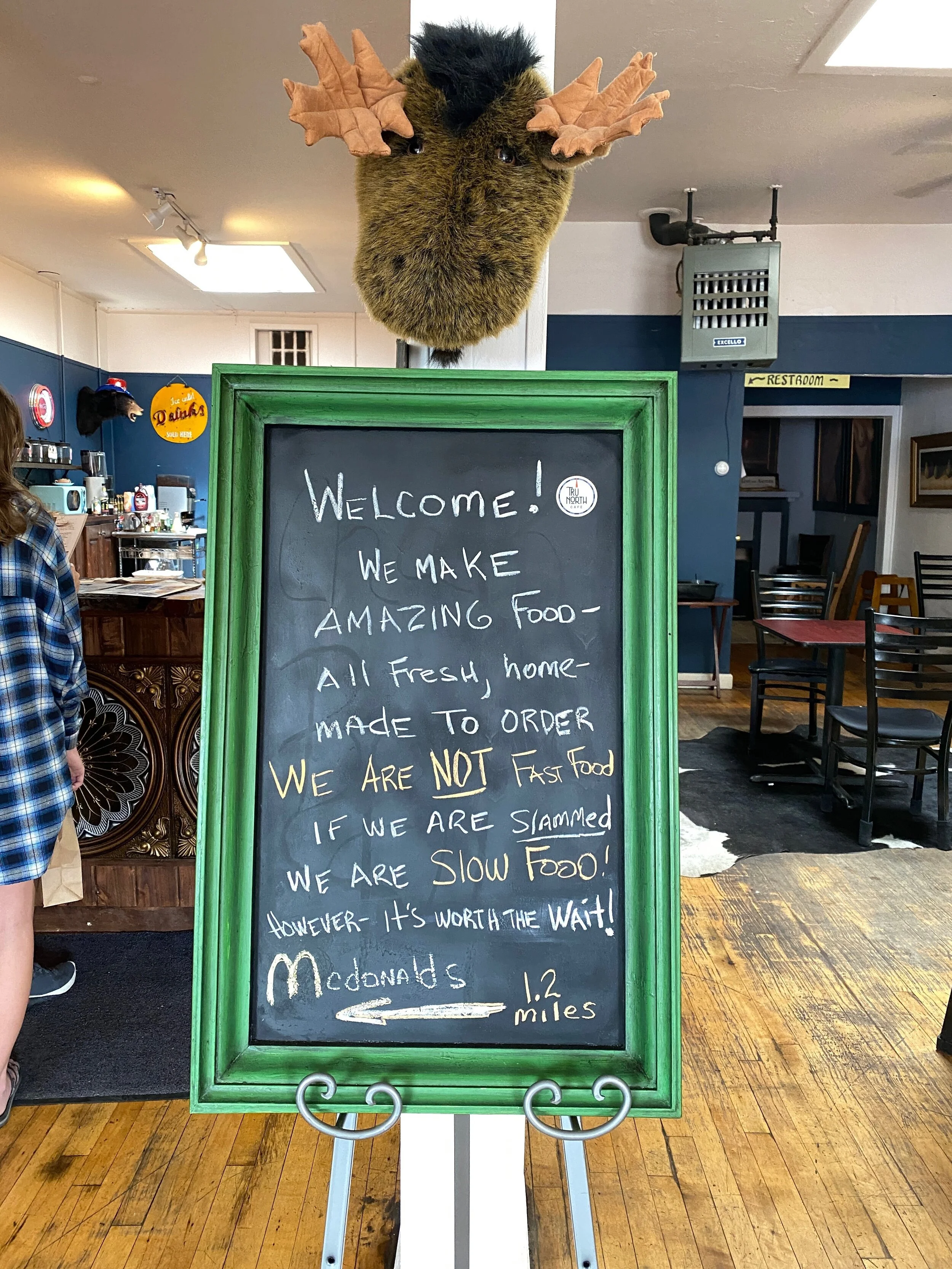Crossroads: Housing & Employment Woes
A sign outside of Neptune’s Taphouse and Eatery in Livingston shows how hard it has been for service industry workers this summer.
Welcome to Paradise?
Craziness seems to beget craziness. At least that appears to be the case following last year’s incredible challenges.
It seems our current housing crisis is running neck-and-neck with a labor shortage, with the leisure and hospitality sector experiencing some of the most extreme changes since the beginning of 2020.
A sign at Tru North Cafe in Livingston asks for patience from customers.
Leisure and food services make up over 22 percent of Park County’s total employment base, higher than any other sector. These are jobs in lodging, food services, event planning and tourism. It makes sense that the pandemic rocked this industry: COVID essentially had us locked up, we went out less, people traveled less and many service-industry workers were laid off.
Colin Davis, owner of Chico Hot Springs, was interviewed by The Daily this week, for a podcast episode titled “Stories From the Great American Labor Shortage.”
The exhaustion in Davis’s voice is evident, as he explains how he had to lay off 150 employees during the pandemic. “They’re all friends. I know every one of them. We had to close for three months,” he said.
Davis probably couldn’t have, however, predicted the challenges that lay ahead post-pandemic. As tourists arrived this summer in record numbers, many jobs at Chico remain open. From a high of 180 employees before COVID, Chico is currently operating with a staff of 130.
And Chico isn’t the only business struggling to find workers.
Gardiner only has two restaurants open for breakfast. Many local businesses are operating with reduced hours, closing a day or two over the course of a week. There are sometimes long wait times at businesses that are open. Some businesses, like Sage Lodge, are offering sign-on bonuses.
Montana’s unemployment rate has been declining since reaching a high of 11.9 percent in April 2020. In May 2021, it was 3.6 percent, among the lowest rates in the country, prompting the governor’s office to offer $1,200 “return-to-work bonuses.”
And Then There’s Housing
Workers are also having a hard time to find a place to live, and recruiting new staff or keeping current staff have become impossible goals without adequate housing. Rentals that have always been available in Livingston and Gardiner have disappeared, many converted to vacation homes.
“Housing cost and lack of availability have negatively impacted our ability to hire, onboard and retain staff,” says Lisa Lowy, Human Resources for the City of Livingston. She says the city is currently down five full-time employees.
Livingston real estate broker and Livingston Zoning Commissioner, Michael Wojdylak (New Millennium Realty), says “there’s quite a little mess out there,” referring to the housing and employment issue throughout Park County.
He says the home market - rentals and sales - “is really tight,” with low inventory. According to Woydylak, the median home price increased over $200,000 in five years from $170K in 2015 to $390K in 2020. The median list price for homes in the Livingston area is currently $475K (with a range of $139K for a one-bedroom, one-bath apartment to a $3.5M property with 6 bedrooms, 4 baths on 15.7 acres).
Welcome to “Boz Angeles”
Housing prices in Bozeman have jumped 49 percent since June 2020.
The housing market is heating up at every turn, particularly over the hill in Bozeman.
In Bozeman, the N. 19th Starbucks is closed Saturdays and Sundays due to an employee shortage. The Bozeman Community Co-op has 16 jobs available, positions ($16/hour minimum wage) ranging from downtown store manager to dishwashers and baristas. The city itself, with 476 employees at full staffing, has 72 vacancies,12 alone in the community development department. Help wanted signs are everywhere.
Meanwhile, the median home price for a single-family home in Bozeman jumped 49 percent since June 2020, to $720,000 June 2021. Over the past week, for the second time in a year, the Wall Street Journal featured the hot Bozeman real estate market: “Real Estate is Booming in Bozeman, MT, or Shall We Say, Boz, Angeles,” 7/29/21.
Rise in Prices, Bidding Wars
Livingston realtor Chip Njaa (Keller Williams) says the local housing market is “so out of whack.” He described a recent “heartbreaking” situation trying to help a young mother who was interested in buying a home. “Her price range was $125,000. There is nothing in that price range,” Njaa said.
Njaa says he’s seeing the effects from the lack of housing options throughout local businesses. Places are short staffed and some places “are only open on certain days.” He also confirms efforts by employers to help with housing.
Njaa says there are generally three groups snatching up available homes: baby boomers, transitory millennials making decent salaries, and, of course, people from Bozeman.
For the past couple of years, we at PCEC have heard firsthand about our own Johnathan Hettinger’s struggles with housing. While buying a house is out of reach for Hettinger right now (he is still paying off student loan debt), renting a place to live has proved challenging. Since moving here three years ago, Hettinger has lived in seven different places.
What To Do About It All
Fixing the housing mess or labor shortage is not as easy as it may sound. While building more homes may sound like the easy way out, we know our community cares about how we grow. Unregulated, unmanaged growth is not advisable as we strive to protect community character, quality of life, natural environment, and local economy. Plus, we have no interest in promoting climate-unfriendly trends.
On the positive front, we’re excited about a couple of efforts currently underway intended to help local housing:
Housing Needs Assessment
The first is the soon-to-be-released Park County Housing Needs Assessment. Prepared by the Human Resource Development Council (HRDC), this document looks at the price of housing (everything from regular rentals, short-term rentals, market rate homes, income restricted homeownership, access and affordability, as well as market gaps and underserved residents). This information will help provide us with important baseline data on the local housing front.
Additionally with HRDC’s help, a local housing working group has been working diligently on potential tools to help address local needs. We will keep you posted when these documents become available.
Adding Inventory with ADU’s and Tiny Homes
The second tidbit of good news is the City of Livingston’s ongoing efforts to expand housing options within city limits. Last fall, the city expanded the legality of accessory dwelling units (ADUs) in town and this month the city will consider whether to allow tiny homes.
Per the American Planning Association (APA), an ADU is a smaller, independent residential dwelling located on the same property as a single-family residence. They have become a popular option in residential subdivisions nationwide for multiple reasons: they can provide an onsite rental option for owners struggling to pay high housing costs and they can help provide housing for a community that needs more housing.
Tiny homes are just as they sound - tiny, 380 to 1,000 square feet - and cost a fraction of the price requiring fewer resources to build and maintain. Tiny homes are marketed as smarter, smaller and more sustainable. Of course, tiny homes are not for everyone and, like other housing options, have advantages and disadvantages.
Wojdylak says tiny homes will appeal to “a certain individual” and is excited about the potential of this option to address workforce housing needs and seasonable tourist fluctuations.
We’re also hopeful about the option of tiny homes and encouraged to see the City of Livingston jumping on the tiny home bandwagon (the city commission is expected to make a preliminary decision on tiny homes at their August 17 meeting). Tiny homes and ADUs help meet our new Growth Policy goals of reducing sprawl and increasing infill within city limits.
While ADU’s, tiny homes, and housing needs assessments aren’t going to end our housing and employment woes, they are positive steps forward out of a mess in which we have found ourselves.
Options Happening Elsewhere
Southwest Montana isn’t the only region experiencing housing and employment challenges. Numerous communities have been working to find achievable options. Cities like Minneapolis have been encouraging increased density in existing neighborhoods by incrementally upzoning zoning in existing neighborhoods.
For instance, neighborhoods traditionally reserved solely for single-family residences, would be able to upzone to allow duplexes. In many older neighborhoods, multi-family housing already exists in R-1 neighborhoods, so the change essentially allows patterns of the past to continue.
Last year, Portland, Oregon, passed what is being described as the best low-density reform in US history, by allowing up to four homes on almost any residential lot. To further incentivize development, Portland has reformed parking requirements in an effort to help facilitate affordable housing.
Park County and Livingston will have to find solutions that are a good fit for our diverse landscapes and communities.
Conflict Mitigation Continued
Park County Planning Board members resume discussions on the proposed Conflict Mitigation draft at their regularly scheduled meeting, Thursday, August 19, 4 p.m. If adopted by the county commissioners, the proposed Conflict Mitigation Regulation would allow local control of some of Park County’s more troubling land use proposals - specifically, industrial and commercial uses.
The proposed Conflict Mitigation Regulation would also help safeguard our agricultural heritage by mitigating impacts from future commercial and industrial uses.
We are hopeful the board will discuss their upcoming schedule, including hosting in-person meetings. PCEC will host a Community Conversation on Conflict Mitigation sometime in September.
Community Conversation Schedule
Neighborhood planning is the topic of our September 1, noon - 1 p.m. Community Conversation. Join us and learn more about the benefits of neighborhood planning, including Gardiner’s neighborhood planning effort and continued efforts on the Livingston Downtown Plan.




